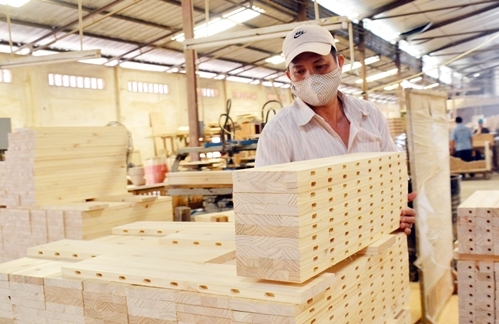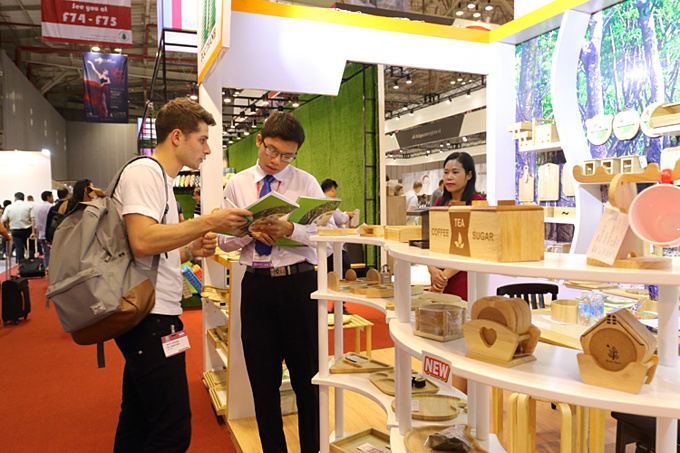News & Events
Difficulties and challenges for Vietnam's wood processing industry
The quality of Vietnamese wooden products has always been improved, able to compete with other countries in the region.
While the market is expanding and the turnover increased rapidly, many businesses in the field of furniture, especially businesses in the city. Ho Chi Minh City, Dong Nai, Gia Lai, Dak Lak, and Binh Dinh said that it is very difficult to find material wood to maintain production. According to the Ministry of Industry and Trade, the material source for the export wood industry is seriously lacking. Every year we have to import 80% of wood material, accounting for 37% of the product cost. Moreover, 90% of wood imported from Laos and Cambodia is exhausted. Since 2005, Malaysia and Indonesia have closed lumber products, causing difficulties for small and medium enterprises. Prices of many types of wood have increased on average from 5% - 7%, especially hardwood has increased from 30% - 40%, making many Vietnamese businesses fall into the state of having orders but not profitable or profitable. very low.
Regarding domestic timber sources, planning is still inadequate, raw material forest development projects have not been given adequate attention, resulting in unimproved timber production for export processing. The National Forestry Strategy for the period 2006 - 2020 aims to develop 825,000 ha of material forests for Vietnam's timber industry, including a combination of trees with short business cycles of 7-10 years and cycles. business for 15 years or more. Expected output exploited for wood industry in 2020 will reach 20 million m3 / year (including 10 million m3 of large timber), only to meet about 70% of demand. According to the calculation of the Wood Association, it is still at least 10 years before hope to be able to take the initiative in part of domestic materials when large timber plantations developed by enterprises begin to be exploited. In the near future, there is no other way to continue importing wood materials.
At present most of the forest land (nearly 5 million hectares) is under the management of State Forest Enterprises and local authorities, while about 3.1 million hectares have been allocated to more than one million households and individuals, but 20-30% of the area is used for the right purpose, the remaining 70% has not brought the expected effect. Meanwhile, many big investors who want to invest in planted forests do not have land to plant forests. However, up to now, a number of cooperation models and linkages between enterprises and forest owners (households, agroforestry enterprises) have appeared to grow production forests. Some enterprises choose to invest money, seeds and techniques for forest planting households. When the exploitation period is reached, households will return to the enterprise a certain amount of timber, the additional output will belong to people. afforestation.
The construction of wood processing networks nationwide has not been consistent to use the scarce resources. Along with the above limitation, the current processing technology is still rudimentary and heavily manual, Vietnamese wood processing enterprises have just stopped at processing raw materials as main, machinery is still at a moderate level. Binh and backward. Most equipment and machinery lines are manufactured from Taiwan, China, only a few are manufactured in Germany, Italy, Japan, do not meet the requirements of large customers and customers who require high quality. . Wood processing enterprises are mainly small and medium enterprises, weak in management capacity, lack of technical workers, lack of capital. These factors make the added value of Vietnamese wood products low and reduce the price competitiveness.
As a new commodity that has been developing well in the last half decade, the development of Vietnam's wooden furniture brand in the international market is limited and not focused. Most Vietnamese wood processing enterprises are small-scale, with limited resources, so there is not much funding to do this. However, the Ministry of Industry and Trade acknowledged that trade promotion has not had a good link between trade support organizations and businesses. Another fact is that businesses mainly sell goods through intermediaries (accounting for 90% of products). Moreover, the increasing number of outsourcing, designing designs, and order contracts have turned our businesses into employees, outsourcers for foreign brands. And all these things are making a big impact on Vietnam's timber brand name in the world market.
Another problem that arises when we integrate deeply into the world economy for furniture is the certification of raw materials. The US has an additional LACEY Act, effective December 15, 2008, which controls the origin of raw wood. From April 1, 2009 all import and export businesses must submit product declarations to ensure legality. Besides forestry law and forest governance (FLEGT) is being implemented in all countries. The EU also launched a "Voluntary Partnership Agreement" (VTA). These are huge barriers for our timber industry. Analysis of the Import-Export Department - Ministry of Industry and Trade recently said that the demand for certified timber is increasing, but Vietnam still does not have an appropriate certification system. Customers (mainly EU) are increasingly demanding products made from certified wood resources from an organization such as the Forest Stewardship Council (FSC). At present, our country has never had such a certificate. As a result, in order to meet the requirements of FSC certification, manufacturers have to import FSC certified timber, the price of products increases, so it is difficult to compete and the added value of the furniture industry is broken. significantly reduced compared to other countries with certification systems, although Vietnam's processed wood furniture is favored in many countries, along with strategic customers, through quality and competitive products. high picture.
In addition, the global economic crisis has also caused many difficulties for Vietnam's wood processing industry such as narrowing the key export markets, unsold goods, reduced output prices, leading to orders. both reduced and difficult to implement. As for the solution to stimulate the Government now with tight lending conditions, difficulties, short lending period, difficult to bring capital with preferential interest rates to small and medium enterprises. However, this can also be a great opportunity for the wood processing industry to restructure to be able to compete, innovate production technology lines, train management staff, labor ...
- Other post
- ➝ The market for wooden furniture is expected to increase
- ➝ Viet Wood faces 3 huge challenges
- ➝ Striving for 2020, the wood industry will reach 12 billion USD
- ➝ Vietnam wood chip market: Link to promote development
- ➝ The price of rubber wood increased: Need to manage closely to avoid risks
- ➝ Business opinion: Derived from competitive raw materials
- ➝ BINH PHUOC: Household afforestation in rubber price storm
- ➝ Furniture exports of Vietnam to attract new markets
- ➝ Wood processing industry exports: Confused by lack of funds
- ➝ Wood processing industry: Exports to the season, which can not be active.
CÔNG TY TNHH MTV THƯƠNG MẠI - XUẤT NHẬP KHẨU THIÊN LỘC
Trụ sở chính: 209 Mã Lò, Khu phố 10, P.Bình Trị Đông A, Q.Bình Tân
VPĐD: 168/14 Nguyễn Súy, P.Tân Phú, Q.Tân Phú, TP.HCM
Điện thoại: 028 5678 0018 - 0909 350 508 - Fax: 028 5678 0016
Email: thienloclumber@gmail.com
Hotline




.jpg)
.jpg)
.jpg)
.jpg)

.jpg)
.jpg)

.jpg)

.jpg)

.jpg)






